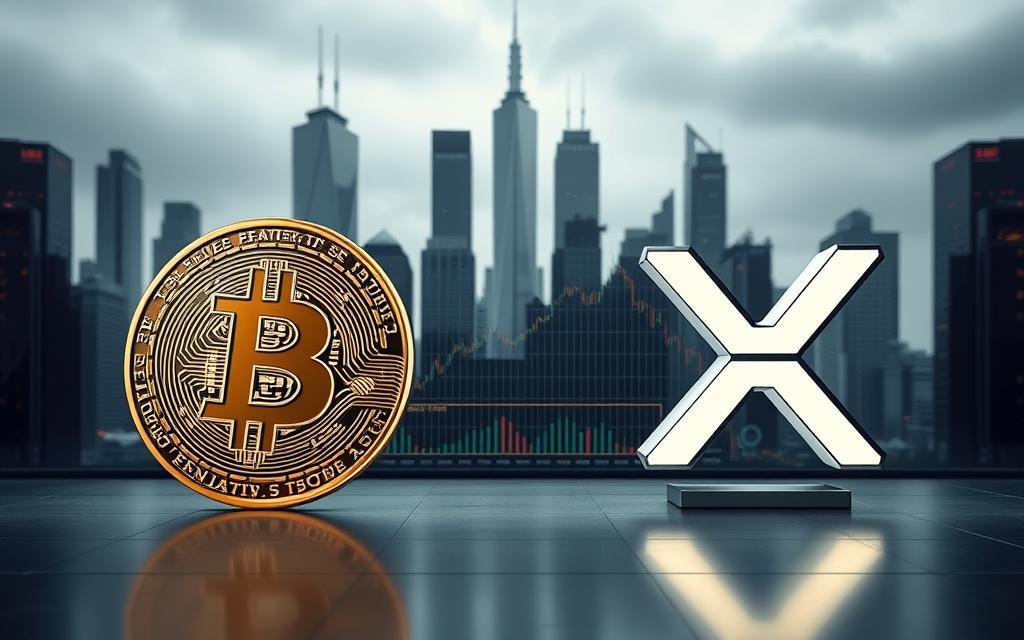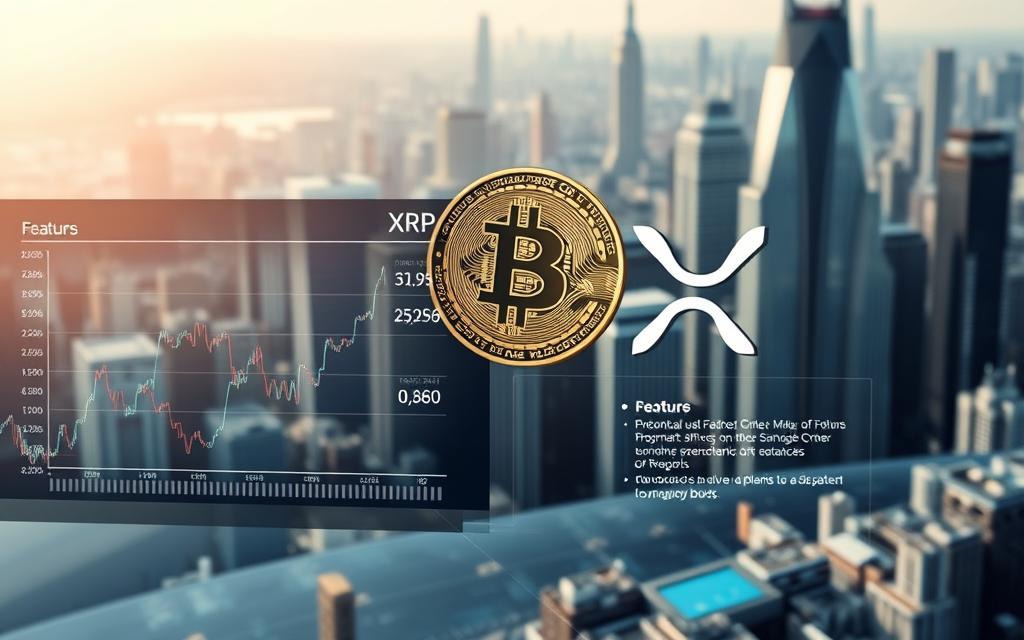Table of Contents
The world of cryptocurrency is abuzz with the question: can XRP follow in Bitcoin’s footsteps? As the largest cryptocurrency, Bitcoin (BTC) boasts a market capitalization of $1.8 trillion, dominating the industry. Meanwhile, XRP, created by Ripple, has garnered attention for its unique use cases and significant price movements.
Last year, Bitcoin and XRP delivered impressive returns of 119% and 235%, respectively, sparking investor curiosity. As the market continues to evolve, understanding the fundamental differences and similarities between these two major cryptocurrencies is crucial for making informed investment decisions.
By examining the potential of XRP in relation to Bitcoin, we can gain valuable insights into the future of the cryptocurrency market. This comparison will help readers make more informed decisions about these digital assets.
The Cryptocurrency Revolution: Bitcoin and XRP Explained
Understanding the cryptocurrency revolution requires a closer look at Bitcoin and XRP, pioneers in the digital asset space. Both have garnered significant attention, but their origins, purposes, and functionalities differ substantially.
The Birth of Bitcoin and Its Impact
Bitcoin, launched in 2009, was the first cryptocurrency and remains the most well-known. It was created as a decentralized alternative to traditional fiat currencies, allowing for peer-to-peer transactions without intermediaries. Bitcoin’s decentralized nature and limited supply have made it an attractive store of value, often compared to digital gold.
As quoted by the Wall Street Journal, “Bitcoin’s underlying technology, blockchain, has the potential to disrupt various industries beyond finance.” This sentiment is echoed by many experts who see Bitcoin as a pioneering force in the broader cryptocurrency market.
XRP’s Origins and the Ripple Connection
XRP, on the other hand, was created by Ripple Labs (then known as OpenCoin) in 2012. Unlike Bitcoin, XRP was designed specifically for financial institutions to facilitate fast and efficient cross-border transactions. The Ripple Payments network is designed to help global banks settle transactions directly, eliminating intermediaries and enabling instant cross-border money flows. Ripple created XRP to give banks an opportunity to standardize transactions.
As part of the Ripple ecosystem, XRP serves as a bridge currency, enabling the exchange of different fiat currencies. Ripple’s business model revolves around providing liquidity for cross-border payments, with XRP playing a crucial role in this process. According to Ripple, “XRP’s ability to settle transactions in seconds at a fraction of a cent makes it an attractive solution for banks and financial institutions.”
The relationship between XRP and Ripple is distinct yet interconnected. While Ripple is the company behind XRP, they are not the same entity. XRP’s initial reception by the banking industry was cautious, but early partnerships helped establish its credibility. Unlike Bitcoin, XRP’s founding philosophy centered around serving the needs of financial institutions, making it a unique player in the cryptocurrency space.
Fundamental Differences Between Bitcoin and XRP
Bitcoin and XRP, though both digital currencies, have unique features that differentiate them in terms of decentralization, supply, and application. Understanding these differences is essential for grasping their potential roles in the cryptocurrency market.
Bitcoin’s Decentralized Nature and Limited Supply
Bitcoin operates on a decentralized network, meaning that no single entity controls it. Its supply is capped at 21 million, with new Bitcoins entering circulation through a process called mining. This decentralized nature and limited supply have contributed to Bitcoin’s appeal as a store of value, often likened to digital gold. As David Schwartz, Ripple’s Chief Technology Officer, once noted, “Bitcoin’s decentralized nature is a significant aspect of its appeal.” Although XRP was designed for the Ripple Payments network, banks don’t actually have to use it; they can still benefit from the network’s instant transfers even if they are using fiat currencies.
The mining process involves solving complex mathematical problems, which helps secure the network. Bitcoin’s blockchain technology ensures transparency and immutability, making it a robust platform for financial transactions.

XRP’s Centralized Structure and Pre-Mined Supply
In contrast, XRP has a total supply of 100 billion tokens, with 58.4 billion in circulation. Ripple controls the remaining 41.6 billion, releasing them gradually to meet demand. This pre-mined supply and Ripple’s control over a significant portion of XRP create a more centralized structure compared to Bitcoin. As a result, XRP’s distribution is more controlled, which can impact its market dynamics. “Ripple’s control over XRP’s supply allows for more predictability in the market,” according to a report by CoinDesk.
The escrow system established by Ripple provides predictability for XRP’s release into the market, helping to stabilize its price. However, XRP’s centralized aspects can affect its perception among cryptocurrency purists who value decentralization. Despite this, XRP’s utility within the Ripple network, particularly for settlement and cross-border transactions, differs significantly from Bitcoin’s role as a standalone store of value.
XRP’s design and Ripple’s control have implications for its regulatory classification and market dynamics. Although XRP is used for various purposes within the Ripple Payments network, its centralized nature sets it apart from decentralized cryptocurrencies like Bitcoin.
Technology Comparison: How Bitcoin and XRP Work
Understanding the technological differences between Bitcoin and XRP is essential for investors and users alike. Both cryptocurrencies have distinct architectures that impact their performance, scalability, and use cases.
Bitcoin’s Blockchain and Mining Process
Bitcoin operates on a decentralized blockchain, utilizing a proof-of-work consensus mechanism that relies on mining to validate transactions. This process involves solving complex mathematical puzzles, which requires significant computational power and energy consumption. As a result, Bitcoin’s transaction processing capacity is limited to approximately 7 transactions per second.
The decentralized nature of Bitcoin’s blockchain ensures security and transparency, but it also leads to higher transaction fees and slower processing times compared to traditional payment systems. The mining process, while energy-intensive, is crucial for maintaining the integrity of the blockchain and preventing double-spending.
XRP Ledger and Consensus Protocol
In contrast, XRP utilizes the XRP Ledger, a decentralized ledger that employs a consensus protocol to validate transactions. This protocol eliminates the need for mining, resulting in faster transaction processing times and lower energy consumption. The XRP Ledger can handle up to 1,500 transactions per second, making it more scalable than Bitcoin.
The XRP Ledger’s consensus protocol is maintained by a network of validators, which ensures the integrity and security of the ledger. This design enables fast and cost-effective cross-border money transfers, with transaction fees as low as 0.00001 XRP (a fraction of $0.01). The efficiency of the XRP Ledger supports its use case for standardizing transactions and facilitating international money transfers without the need for intermediaries.
The key advantages of XRP’s technology include its high transaction capacity, low fees, and fast settlement times, making it an attractive option for financial institutions and individuals seeking to transfer money efficiently.
Use Cases and Real-World Applications
Both Bitcoin and XRP have unique use cases that are shaping their roles in the global financial system. While Bitcoin is often viewed as a store of value, XRP is closely tied to the Ripple Payments Network, facilitating cross-border transactions.
Bitcoin as a Store of Value and Digital Gold
Bitcoin’s primary use case is as a store of value and a form of digital gold. Investors view it as a hedge against inflation and market volatility. Its limited supply and decentralized nature make it an attractive option for those looking to diversify their portfolios.
As a digital asset, Bitcoin offers a level of security and transparency that is hard to match with traditional assets. Its growing acceptance among institutional investors further solidifies its position as a store of value.

XRP and the Ripple Payments Network
XRP, on the other hand, is integral to the Ripple Payments Network, which is designed to facilitate fast and cost-effective cross-border transactions. The Ripple Payments network enables global banks to settle transactions directly, eliminating the need for intermediaries and reducing settlement times.
XRP functions as a bridge currency within this network, facilitating cross-border transfers. The On-Demand Liquidity (ODL) service, which utilizes XRP, provides liquidity for international payments without the need for pre-funding. This has the potential to disrupt the $1.8 trillion cross-border payments industry.
- XRP enables fast and cost-effective cross-border transactions through the Ripple Payments Network.
- The On-Demand Liquidity service uses XRP to provide liquidity without pre-funding.
- Financial institutions worldwide are adopting Ripple’s technology to improve their payment systems.
The adoption of Ripple’s technology by banks and payment providers is a testament to the potential of XRP to transform the global payments landscape. By reducing the cost and time associated with international money transfers, XRP is poised to play a significant role in the future of cross-border payments.
Market Performance and Historical Growth
Understanding the market performance of Bitcoin and XRP is crucial for investors looking to navigate the cryptocurrency landscape. Both cryptocurrencies have experienced significant growth, but their market trajectories have been influenced by different factors.
Bitcoin’s Price History and Market Dominance
Bitcoin has historically been the leading cryptocurrency in terms of market capitalization. Its price history has been marked by significant volatility, with a peak during the 2017-2018 cryptocurrency bull market. Bitcoin’s price movements have been influenced by factors such as adoption rates, regulatory developments, and macroeconomic trends.
Key statistics in Bitcoin’s price history include:
| Year | Peak Price | Notable Events |
|---|---|---|
| 2017 | $19,666 | Cryptocurrency bull market |
| 2020 | $64,804 | COVID-19 pandemic, institutional investment |
XRP’s Price Movements and Market Challenges
XRP’s price history has been closely tied to developments within the Ripple ecosystem, as well as broader cryptocurrency market trends. Despite not reaching new record highs since 2018, XRP has shown resilience, particularly following positive legal developments in the SEC case against Ripple.
The impact of regulatory uncertainty on XRP’s market performance is notable. The SEC lawsuit against Ripple led to significant price volatility and affected XRP’s listings on various cryptocurrency exchanges. However, the August 2024 ruling provided clarity, with the judge determining that XRP is not a security in all circumstances, which was viewed positively by investors.
XRP’s price movements have been influenced by:
- Developments in the Ripple payments network
- Regulatory clarity and legal challenges
- Broader cryptocurrency market trends

Is XRP the Next Bitcoin? Analyzing the Potential
Investors are keenly debating whether XRP might be the next Bitcoin, but is this comparison valid? To answer this, we need to examine both the similarities that support the comparison and the critical differences that challenge it.
Similarities That Support the Comparison
Both Bitcoin and XRP are digital assets that utilize cryptographic techniques for secure financial transactions. XRP, like Bitcoin, has garnered significant attention in the financial world for its potential to revolutionize cross-border payments. One key similarity is their ability to facilitate fast and relatively low-cost transactions compared to traditional financial systems.
Moreover, both cryptocurrencies have a degree of acceptance within certain communities and industries. Bitcoin is widely recognized as a store of value, while XRP is closely associated with the Ripple Payments network, which aims to improve the efficiency of international money transfers.
- Both are digital assets using cryptographic techniques.
- They facilitate fast and relatively low-cost transactions.
- Both have garnered significant financial world attention.
Critical Differences That Challenge the Comparison
A critical examination reveals substantial differences between Bitcoin and XRP. Bitcoin is decentralized, with a limited supply and a focus on being a store of value or “digital gold.” In contrast, XRP is centralized, with a pre-mined supply and a primary function as a facilitator of payments within the Ripple network.
The success of Ripple Payments doesn’t necessarily translate into a higher price for XRP because banks can benefit from the network without using XRP. This might better position Ripple for success, but it doesn’t directly impact XRP’s value. Thus, calling XRP the “next Bitcoin” might be misleading, as their use cases and structures differ significantly. In fact, XRP could be considered a better buy for those looking for a different investment opportunity, not necessarily a direct competitor to Bitcoin.

In conclusion, while both cryptocurrencies have their unique strengths, the path forward for XRP is distinct from Bitcoin’s trajectory. Understanding these differences is crucial for investors considering whether XRP is a viable alternative or a complementary asset to Bitcoin in their investment portfolios.
Regulatory Landscape and Legal Challenges
Understanding the regulatory landscape is crucial for investors and users of cryptocurrencies such as Bitcoin and XRP. The regulatory environment for these digital assets is complex and constantly evolving.
Bitcoin’s Regulatory Status Worldwide
Bitcoin’s regulatory status varies significantly across different countries. Some nations have embraced it, while others have imposed strict regulations or outright bans. In the United States, Bitcoin is considered a commodity by the Commodity Futures Trading Commission (CFTC), which has implications for its regulatory oversight.
The classification of Bitcoin as a commodity rather than a security has provided a degree of clarity for its regulatory treatment. However, this does not mean that Bitcoin is entirely unregulated. Exchanges and trading platforms that offer Bitcoin futures or other derivatives are subject to CFTC regulations.
- Regulatory clarity has helped Bitcoin gain more mainstream acceptance.
- Countries with favorable regulations have seen increased Bitcoin adoption.
XRP’s SEC Battle and Regulatory Hurdles
The Securities and Exchange Commission (SEC) sued Ripple in 2020, alleging that XRP constitutes an unregistered securities offering. This legal challenge has had significant implications for XRP’s market availability and Ripple’s business operations.
The court’s ruling that XRP is not necessarily a security in all contexts was a crucial development. However, the SEC’s appeal and the subsequent pause in the case under new leadership have created uncertainty about the future regulatory treatment of XRP.

The outcome of this case will have broader implications for other cryptocurrencies and the regulatory framework in the United States. Ripple’s settlement prospects with the SEC could be influenced by the new leadership and its approach to cryptocurrency regulation.
- The SEC’s lawsuit against Ripple highlighted the regulatory challenges faced by company-issued cryptocurrencies.
- XRP’s classification as a potential financial security has been a central issue in the legal battle.
- A favorable settlement could provide clarity for Ripple and potentially other cryptocurrency companies.
Institutional Adoption and Investment Vehicles
As cryptocurrencies gain mainstream acceptance, institutional investors are turning their attention to Bitcoin and XRP. This shift is driven by the potential for growth and the increasing integration of digital assets into traditional financial systems.
Bitcoin ETFs and Corporate Treasury Investments
Bitcoin has seen significant institutional investment through Exchange-Traded Funds (ETFs) and corporate treasury investments. Bitcoin ETFs offer a regulated and accessible way for institutions to invest in the cryptocurrency. Companies like MicroStrategy have led the way by investing heavily in Bitcoin, demonstrating its appeal as a store of value. The introduction of Bitcoin ETFs has simplified the investment process, making it more attractive to institutional investors.

XRP’s Institutional Partnerships and Adoption Barriers
XRP, on the other hand, has focused on institutional partnerships within the banking industry. Ripple, the company behind XRP, has established numerous partnerships with financial institutions to facilitate cross-border payments. However, XRP’s adoption has been partly hindered by regulatory uncertainty, particularly following the SEC lawsuit in 2020. Despite these challenges, RippleNet has played a crucial role in promoting institutional adoption by offering enterprise solutions that can be used with or without XRP.
| Institutional Investment Aspect | Bitcoin | XRP |
|---|---|---|
| Primary Investment Vehicle | ETFs and Corporate Investments | Partnerships with Financial Institutions |
| Regulatory Challenges | Regulatory Clarity | SEC Lawsuit and Regulatory Uncertainty |
| Market Impact | Significant Market Influence | Growing Adoption in Cross-Border Payments |
Future Outlook: Growth Catalysts for Both Cryptocurrencies
The outlook for Bitcoin and XRP is promising, with several factors potentially driving their growth. As the cryptocurrency market continues to evolve, understanding these catalysts is crucial for investors and enthusiasts alike.
Bitcoin’s Path Forward: ETFs and Government Reserves
Bitcoin’s future growth could be significantly influenced by the introduction of Exchange-Traded Funds (ETFs) and the adoption of Bitcoin as a reserve asset by governments. The approval of a Bitcoin ETF would provide a more accessible investment vehicle for institutional investors, potentially leading to increased demand and higher prices. Moreover, if governments begin to hold Bitcoin as a reserve asset, it could further legitimize its status as a store of value, thereby driving its price upward.

XRP’s Potential: Regulatory Clarity and Payment Network Expansion
For XRP, regulatory clarity is a major catalyst for growth. The recent change in SEC leadership, with Paul Atkins being sworn in as chairman, could signal a more favorable regulatory environment for cryptocurrencies like XRP. With clearer regulations, XRP could be relisted on major exchanges, attracting new investors and potentially increasing its price. Additionally, Ripple’s ongoing expansion of its payment network, particularly in regions with inefficient banking systems, could drive adoption and increase the demand for XRP. The growing trend toward faster, cheaper international money transfers also positions XRP favorably for future growth.
- Regulatory clarity could significantly boost XRP’s adoption and price.
- The new SEC leadership may foster a more favorable environment for cryptocurrency innovation.
- Ripple’s global expansion of its payment network could drive XRP’s growth.
Conclusion: Making an Informed Investment Decision
As investors weigh their options between Bitcoin and XRP, understanding the distinct characteristics of each cryptocurrency is crucial. Bitcoin has established itself as a legitimate store of value with significant institutional acceptance. In contrast, XRP offers utility in cross-border payments through the Ripple network.
When evaluating these cryptocurrencies, investors should consider their unique value propositions and the challenges they face. Bitcoin might be the better buy in 2025 and beyond, especially with the U.S. government establishing a strategic reserve, potentially making it an active buyer. Ultimately, investors must consider their own investment goals, risk tolerance, and time horizon when deciding between these assets.
Both Bitcoin and XRP have potential merits, but it’s essential for investors to conduct their own research before investing in the world’s largest and most complex cryptocurrency market.
FAQ
What is the main difference between Bitcoin and XRP?
Bitcoin is a decentralized cryptocurrency with a limited supply, while XRP is a centralized cryptocurrency with a pre-mined supply, primarily used for cross-border payments through the Ripple network.
How does XRP’s Ripple payments network work?
The Ripple payments network utilizes XRP to facilitate fast and cost-effective international transactions, enabling financial institutions to settle payments in real-time, reducing the need for correspondent banking, and standardizing transactions.
What is the current regulatory status of XRP?
XRP has faced regulatory hurdles, particularly with the SEC, which has impacted its adoption and price movements; however, Ripple continues to work towards achieving regulatory clarity.
Can XRP be considered a legitimate store of value like Bitcoin?
While XRP has its use cases, its legitimacy as a store of value is debated due to its centralized nature and the significant supply held by Ripple; nonetheless, it remains a popular cryptocurrency with a substantial market capitalization.
How do ETFs impact the adoption of Bitcoin and XRP?
The availability of ETFs can increase institutional investment in both cryptocurrencies, potentially driving growth; however, the approval of ETFs for XRP is pending, and regulatory clarity is needed.
What are the potential growth catalysts for XRP?
Regulatory clarity, expansion of the Ripple payments network, and increased adoption by financial institutions are potential growth catalysts for XRP, which could positively impact its price and market capitalization.
How does XRP’s market performance compare to Bitcoin’s?
XRP’s price movements have been influenced by its regulatory challenges and adoption barriers, whereas Bitcoin’s price history has been shaped by its market dominance and store of value narrative.









